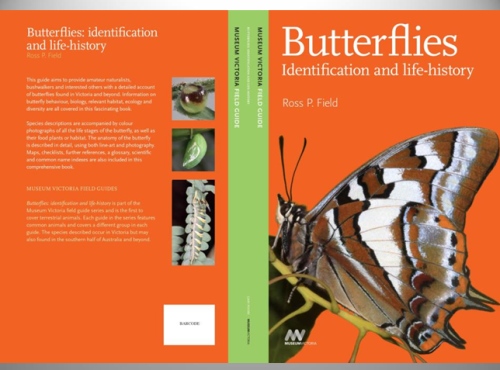Video conference notes 30 July 2015 - Moths and Butterflies
SWIFFT video conference notes are a summary of the video conference and not intended to be a definitive record of presentations made and issues discussed.
This video conference was supported through resources and technology provided by the Department of Environment, Land, Water and Planning, Victoria. SWIFFT wishes to thank speakers for their time and delivery of presentations.
This was the third video conference for 2015 which had a theme on Moths and Butterflies.
A total of 59 participants were connected across 11 locations; Ararat, Ballarat, Benalla, Bendigo, Geelong, Hamilton, Heywood, Horsham, Heidelberg (Arthur Rylah Institute), Melbourne (Nicholson Street) and Warrnambool.
List of groups/organisations in attendance;
Educational: Federation University, Gordon TAFE, La Trobe University.
Local Government: Banyule City, Southern Grampians Shire.
Field Naturalist Clubs: Geelong, Hamilton, Portland.
Community Conservation Groups: Geelong Environment Council, Bellarine Landcare, Friends of Eastern Otways, Horsham Rural City Landcare, Moyston Landcare, Wombat Forestcare.
Conservation Organisations: Wimmera CMA, Parks Victoria, Bellarine Bayside Committee of Management, Department of Economic Development, Jobs, Transport and Resources (DEDJTR), Department of Environment, Land, Water and Planning (DEWLP) staff across 13 locations, inc. Nicholson Street Melbourne and Arthur Rylah Institute, Heidelberg,
Industry: ISG Projects, Amaryllis Environmental Consultant.
KEY POINTS SUMMARY - Quick take home messages from this video conference or read through the speaker summaries.
SPEAKER SUMMARIES
Butterflies – Victoria's rare and threatened species
Box Ironbark: Fundamental Lepidopteran Ecology
Eltham Copper Butterfly Conservation in the Loddon Mallee region
Butterflies – Victoria's rare and threatened species - Dr Ross Field, former head of Sciences at Museum Victoria and author of Butterflies: Identification and life history. A Museum Victoria field guide.
Ross introduced his talk by looking at the invertebrate species listed under the Victorian Flora and Fauna Guarantee Act 1988, pointing out that insects form the highest number of species listed with 35 species comprising 19 species of butterflies .
Ross spoke about the 19 species of butterflies listed under the Victorian Flora and Fauna Guarantee Act 1988 and provided an overview of the families.
| Family | No. listed |
| Hesperiidae (skippers) | 4 |
| Pailionidae (swallowtails) | 0 |
| Pieridae (whites) | 0 |
| Nymphalidae (browns) | 3 |
| Lycaenidae (blues) | 12 |
| Total | 19 |
Ross also pointed out that there are another 5 species (3 skippers and 2 blues) that are on the Advisory List but not listed.
Possible reasons for scarcity of rare and FFG listed butterflies
Ross spoke about some of the reasons why species of butterflies in Victoria are considered rare or threatened.
At extreme of range - (a number of species come down from northern Australia and touch northern Victoria in East Gippsland)
Habitat loss (e.g. Eltham Copper Butterfly)
Highly specialised ecological requirements (particularly for the Lycaenids (blues) such as:
(a) single or few species of host plants on which they feed.
(b) complex biology with obligatory dependency on >1 species -for Lycaenid butterflies this could be one species of ant.
(c) predatory species (larvae predatory on ants) - some species of butterfly larvae are dependent on one particular prey species of ant. Out of the 19 FFG listed species there are at least 4 species which are regarded as predatory. Unless those prey species are abundant you will not find the particular species of butterflies present.
(d) adults seldom seen - some species are difficult to find because of their hill-topping behaviour where they are only readily found on specific hill tops. (These species are often refered to as hill toppers).
Flora & Fauna Guarantee listed Butterflies
- Regionally Extinct (3 species) (2 species are considered extinct but the Bright-eyed Brown, Heteronympha cordace wilsoni (is now considered not extinct)
- Critically endangered (4 species)
- Endangered (5 species)
- Vulnerable (6 species + 1 taxonomically invalid)
Regionally Extinct Butterflies
Bright-eyed Brown, Heteronympha cordace wilsoni (Family Nymphalidae) (not extinct in Victoria)
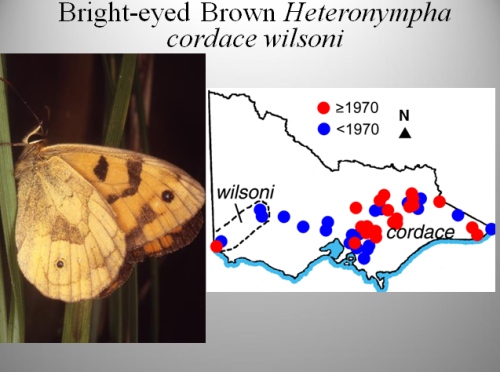
The Bright-eyed brown sub-species Heteronympha cordace wilsoni (above) was thought to be extinct but has been found near the mouth of the Glenelg River at Nelson where it occurs only in association with Carex appressa sedges along the edge of the river.
Orange Ringlet, Hypocysta adiante (Family Nymphalidae) - probably at the extremity of its range from northern Australia. It specialises on kangaroo grass which has been severely depleted in Victoria.
Eastern Large Bronze Azure, Ogyris halmaturia (Family Lycaenidae) - a predatory species which has not been seen in Vitoria for more than 50 years.
Critically endangered butterflies
Eltham (Fiery) Copper, Paralucia pyrodiscus lucida (Family Lycaenidae) - more details in following presentation.
Small Ant-blue, Acrodipsas myrmecophila (Family Lycaenidae) - a predatory species and hill top species rarely seen.
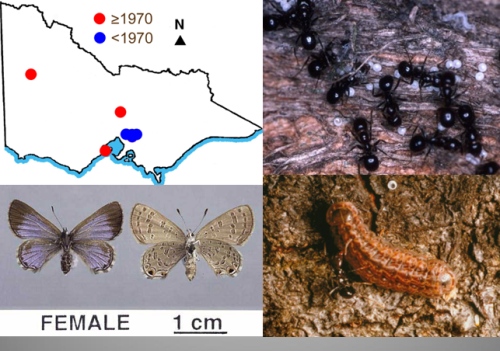
The Small Ant Blue Acrodipsas myrmecophila (above) was commonly found at Ocean Grove 40-50 years ago but its population is now very low being found in the Mallee and at Mt Piper in central Victoria where it flies on hill tops or on the top of sand ridges. It is a predartory species found in association with a specific species of ant which the larvae feed on.
Golden-rayed Blue, Candalides noelkeri (Family Lycaenidae) found in the Wimmera around salt lakes and feeding on a specific host plant. It is Victoria's only endemic species of butterfly.
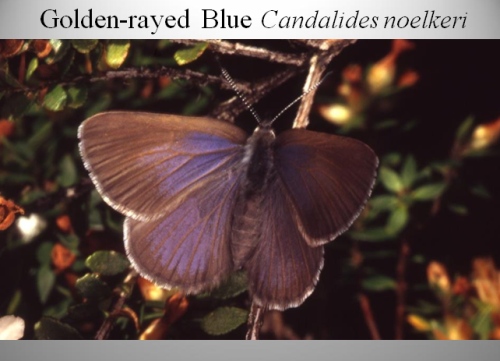
The Golden-rayed Blue Candalides noelkeri (above) is Victoria's only endemic species of butterfly. It is only found in the Wimmera around salt lakes and feeds on a specific host plant Myoporum parvifolium Creeping Boobialla.
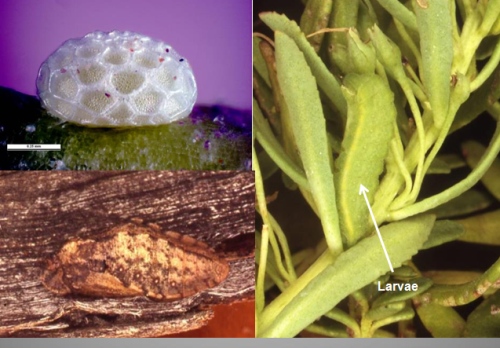
The egg and larvae of the Golden-rayed Blue (above). Note how the larvae is highly camouflaged amongst the leaves of the Myoporum parvifolium.
Small Bronze Azure, Ogyris otanes (Family Lycaenidae) restricted to the Big Desert area and is a hill topper.
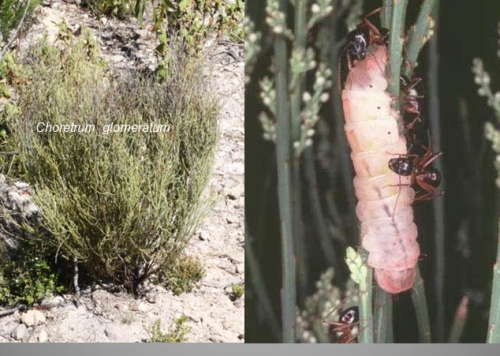
The Small Bronze Azure Ogyris otanes (above) is only found in the Big Desert where it feeds on Sour-Bush Choretrum glomeratum. The larvae are attended by a particular species of sugar ants which live at the base of the plant.
Endangered butterflies
Bronze Ant-blue, Acrodipsas brisbanensis (Family Lycaenidae) is a predatory species and hill topper species which have been found at Mt Piper flying at the top of the tallest trees.
Diamond Sand-skipper, Antipodia atralba (Family Hesperiidae)
Small Alpine Xenica, Oreixenica latialis theddora (Family Nymphalidae) is only found in the Alpine areas, restricted to Mt Buffalo in association with Poa sp.
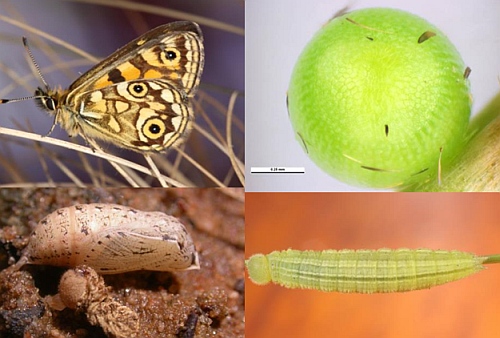
Small Alpine Xenica, egg, larvae and pupae (above).
Bitter Bush-blue, Theclinesthes albocincta (Family Lycaenidae)
Yellow Ochre, Trapezites luteus luteus (Family Hesperiidae) is found in association with Lomandra longifolia and Lomandra filiformis. The larvae builds a shelter at the base of the plant and comes out at night to feed.
Vulnerable butterflies
Yellow Sedge-skipper, Hesperilla flavescens flavescens (Family Hesperiidae)
Fiery Jewel, Hypochrysops ignitus ignitus (Family Lycaenidae) a number of host plants are used, the most common being Brachyloma daphnoides. The larvae lives with a specific species of coconut ants at the base of the plant and come out at night to feed. They have also been known to use Acacias and Choretrum.
Amethyst Hairstreak, Jalmenus icilius (Family Lycaenidae) has a number of host plants with most of the southern Victorian populations utilising Wattles including Acacia melanoxylon near Riddles Creek. It also has attendant ants.
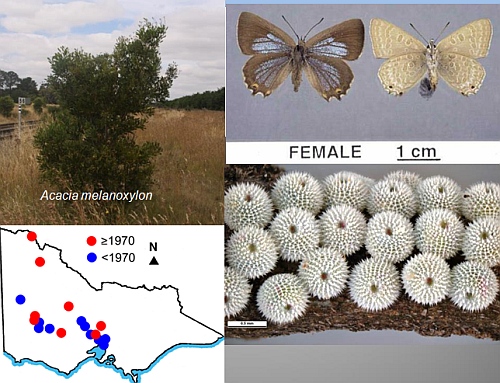
Amethyst Hairstreak, eggs and distribution (above).
Southern Purple Azure, Ogyris genoveva araxes (Family Lycaenidae)
Arid Bronze Azure, Ogyris subterrestris subterrestris (Family Lycaenidae) is a predatory species and hill topper species which have been found at Mt Piper flying at the top of the tallest trees. It is found in association with a species of sugar ant Camponotus terebrans. In some cases the ants tend the larvae whilst it has also been known for the larvae to feed on the ant brood.
Southern Sedge-darter, Telicota eurychlora (Family Hesperiidae) feeds on a semi aquatic sedge Cladium procerum at only one specific location in far eastern Victoria near Point Hicks where it is at the edge of its range with the nearest population in NSW some 200km away.
Questions to ask about rare and threatened butterflies
Is there habitat loss?
Is the species at the end of its range?
Is the species migratory or a vagrant?
Do we know fully the life history?
Is it difficult to observe the adults or any of the other life stages?
Is it a predatory species with high prey specificity?
Key points from questions
- Good areas of the semi aquatic sedge Cladium procerum have been found at the lower Snowy wetlands which could reveal further records of the Southern Sedge-darter.
- It has been found that the range for a number of species of butterflies has moved further south, possibly due to a changing climate. Over the past 4-5 years there have been 3-4 new species previously unknown found in Victoria through range extensions.
- Using ants as a general indicator to determine the occurrence of butterflies with ant associations is limited because as a general rule ant species tend to be more widespread than butterflies. Using ants as an indicator tends to be more relevant in cases where a particular species of ant is in high abundance.
Further reading
Butterflies: Identification and life history. A Museum Victoria field guide. or CSIRO Publishing
Butterflies - bioinformatics Museum Victoria
Butterflies of Victoria - Museum Victoria
Box Ironbark: Fundamental Lepidopteran Ecology - Steve Williams
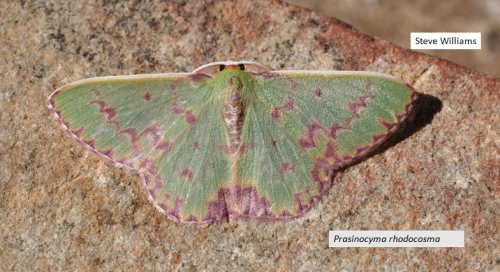
Steve has been studying moths for about 5 years and feels moths are undervalued in terms of their ecosystem function services probably due to the difficulties associated with their research.
Conventional approaches to invertebrates surveys don’t work well for Lepidoptera. Steve said there are large gaps in knowledge as early life phases are cryptic with superb adaption. There are at least 4,500 species of moths in Victoria probably nearer 8000. Australia has a rich diversity of moths with about 20,000 species.
Moths are closely associated with plants in all forms. They are low in the food chain and are major contributors in turning plant material into protein. They are an important part in food-chains because these are the insects other invertebrates eat.
Steve has been undertaking a systematic observation of moths in the ecosystem. He has undertaken 5 years of nightly monitoring in box ironbark forests and has 60,000 sightings identified down to species level with some sighting being made for the first time. During monitoring he also records weather patterns, temperature (approx. hourly), wind, rain and phase of the moon.
Rearing studies
Steve has been undertaking systematic studies to learn more about moth ecology. During his field observations he collects a selection of female moths to be studied and rears them until eggs are laid which he can rear to study their life cycle and gain an insight into their ecology.
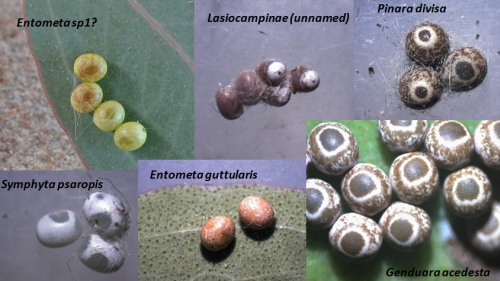
Species of moth eggs. To-date more than 300 individual species have been reared and documented including the length of each stage in the life cycle. Steve has 12,000 + photographs of pre-adult life stages and 30,000 + photographs of adult moths.
Host plant studies
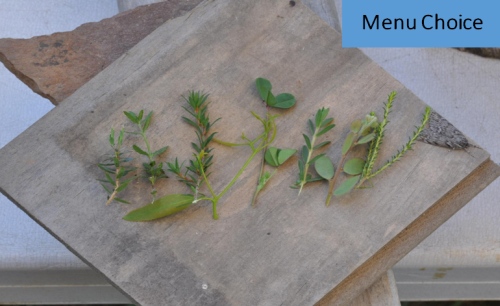
There is scant information regarding the biology of most species of moths. Steve conducts studies to see which plant families and species are the host plants for the species of moth being studied.
Example of a species being studied
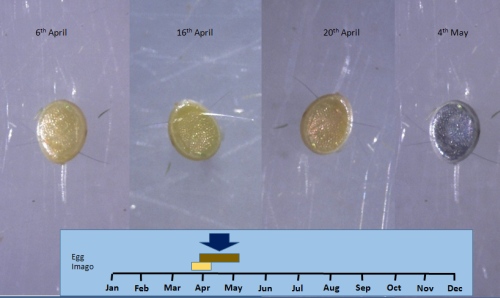
April 6 - Selected species of egg collected in April and reared from April 6 to May 4 (above)
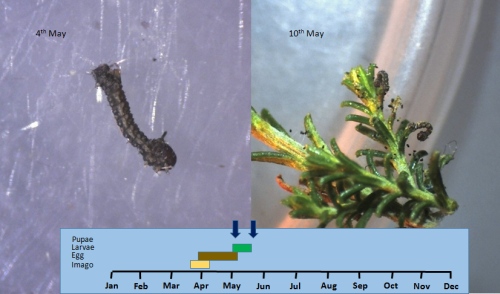
May 4 - The eggs have hatched and larvae is one day old (left), a week later they are on the host plant which in this case is a Drooping Cassinia.
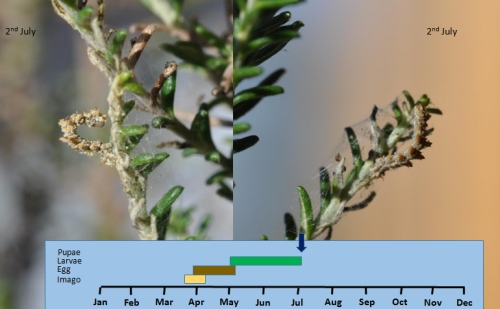
July 2 - The larvae lays down a web of silk on the host plant, possibly to discourage ants.
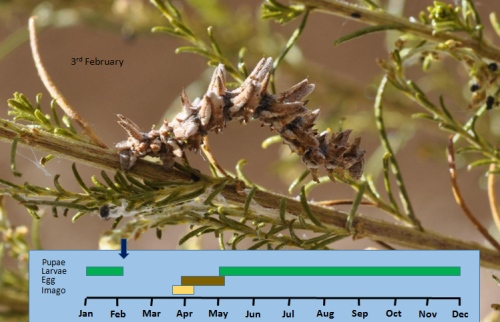
February 3 - Larvae nearing pupation.
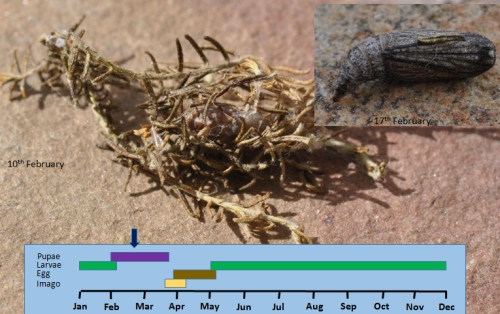
February 10 - The larvae begins the process of pupation. By February 17 the pupae is fully formed (inset top right).
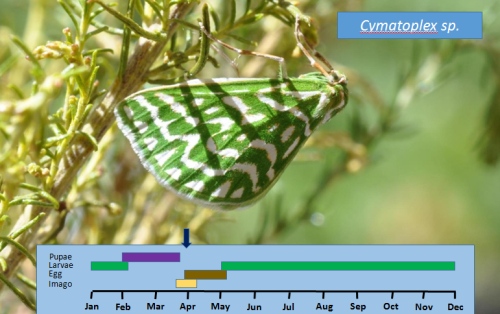
March - The new moth Cymatoplex sp. emerges (above) but it only flies for about a fortnight. This is one of the rarest moths in Victoria with only about 12 formal records over the last 100 years. This specie of moth is on Steve's property near Bendigo and despite many people searching for more records it is only known from one other location in Victoria near Fryerstown.
Plant phenology and moth life-cycle
As an example, Steve spoke about relationships between the Cotton Fireweed host plant and the Magpie Moth. Steve recorded the growth of the Cotton Fireweed in Central Victoria which begins to emerge in the cooler months growing through winter and dying out around late December which also corresponds to the emergence and flight of the Magpie Moth.
Seasonal impacts
Steve spoke about the influence of changing seasonal rainfall and how it can impact on the abundance of moths from one year to the next by altering the timing of emergence which could be detrimental if moths emerge when host plant growth is reduced or unavailable because of dry conditions.
Host species
Steve showed a series of images demonstrating how some species of moths use various host plants including, lichens, fungi & mosses and leaf litter at different times of the year.
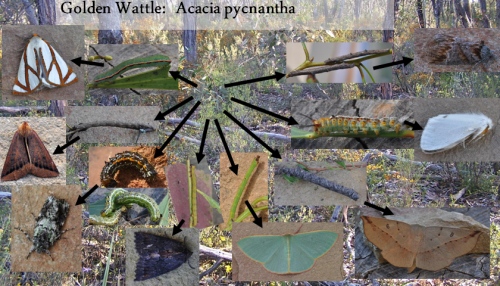
The ecological value of golden wattle for moth diversity (above).
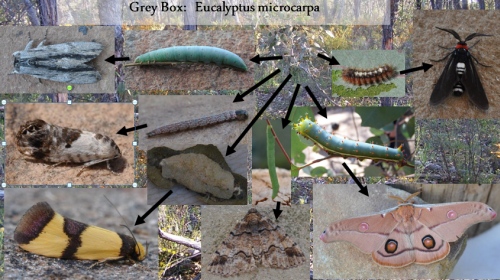
The ecological value of Grey Box for moth diversity (above).
Host species occupation profile
By studying the life cycle of many species of moths Steve has been able to document the time of year and abundance of moths feeding on host plants. He has found different species of moth can feed on the same host plant at different times of the year or that some host plants can provide for multiple species at certain times of the year. In other cases certain species of moth have very specific times when they feed on the host plant e.g. when young leaves are forming. Steve's studies have demonstrated the complexity of understanding moth ecology and feeding requirements together with our need to consider impacts of human management intervention in the ecosystem.
Moth diversity and relationship with habitat diversity
Through looking at the ecological processes of moths and the way they interact with their environment Steve has been able to gain an insight into the importance of maintaining a healthy ecosystem which builds on having diverse flora and structure of ground cover.
Steve has counted up to 800 species of moths on his property which is managed to retain diverse flora and structural integrity of the ground layer. He compared the moth diversity to nearby forests which have been thinned and frequently burnt where the moth diversity has been reduced to 250-400 species and within a recent burn area where the diversity was only 60-90 species.
Key points from questions
The type of research Steve is conducting by rearing moth eggs and undertaking plant preference trial on moths provides a valuable insight into their ecology. It also sheds light on the relationships between floristic diversity, invertebrate diversity and ecosystem health.
Eltham Copper Butterfly Conservation in the Loddon Mallee region - Julie Whitfield, Amaryllis Environmental
Julie operates the environmental consultancy Amaryllis Environmental and has been involved with conservation of the Eltham Copper Butterfly since 2007. In particular she highlighted the powerful effects of community engagement on rare species such as the Eltham Copper Butterfly.
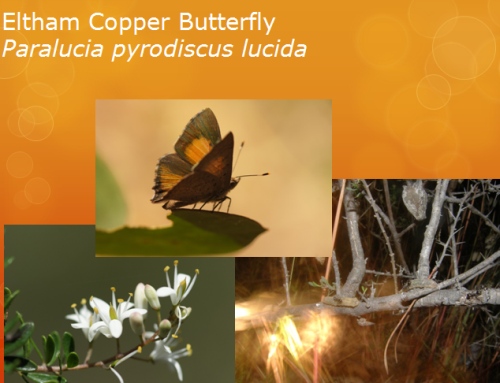
Eltham Copper Butterfly - key dates
- Discovered in 1938
- Became extinct around 1950s
- Rediscovered in Eltham in a housing development area in 1986
- First ever invertebrate to be listed under FFG Act in 1991
- Prior to 2007 only known locations where Eltham, Greensborough, Kiata and Castlemaine
Conservation status of the Eltham Copper Butterfly
Considered Vulnerable in the Action Plan for Australian Butterflies (Sands and New 2002)
In Victoria the Eltham Copper Butterfly is considered endangered.* It is also Listed under the Victorian Flora and Fauna Guarantee Act 1988 **
In its final recommendations, the Scientific Advisory Committee (SAC 1991) stated the Eltham Copper Butterfly is:
- in a demonstrable state of decline which is likely to result in extinction;
- significantly prone to future threats which are likely to result in extinction; and
- very rare in terms of abundance and distribution.
Julie said the Eltham Copper Butterfly has been recommended for listing under the Environment Protection and Biodiversity Conservation Act 1999.
Current distribution
Julie spoke about the known sites in Victoria which include;
Eltham and Greensborough area - 10 sites across different tenure and management i.e. Parks Vic, Local Council and Private land
Kiata and Salisbury - 6 sites
Castlemaine - 5 sites within, National Park, Botanic Gardens & State Forest
Bendigo - 6 sites within National Park and 1 private land
Highlights for Eltham Copper Butterfly conservation
Julie spoke about the progress towards ensuring this species survival.
- Reserves have been set aside for Eltham Copper Butterfly conservation in Eltham.
- Habitat mapping throughout Bendigo and Castlemaine area.
- Addition of 9 new populations state wide since 2008.
- Funding: near a million dollars over past ten years across all locations (including a single grant of $450,000 through combined delivery agents in Eltham area).
- Input into fuel reduction burning in the Loddon Mallee region, altered timing of burns and exclusion zones established at 7 of the 11 locations to date.
- Proposed genetic research studies.
- Community engagement, on ground works, surveys, involvement of schools and festivals.
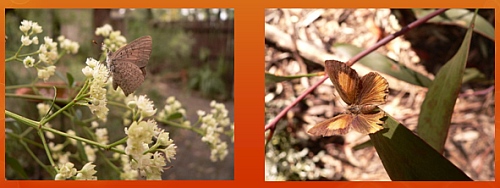
Conservation efforts
Julie spoke about the role of community groups such as the Friends of Kalimna, Friends of Botanic Gardens, Castlemaine Field Naturalists who had already spent many years in conserving the only two known location of Eltham Copper Butterfly in the Loddon Mallee region prior to 2008.
2007/08 a new population of Eltham Copper Butterfly was discovered in the Bendigo area which generated a lot of interest eventually leading to the first government commitment of annual funding in 2009 for monitoring at the Castlemain Botanic Gardens, Big Hill and Kalimna . Funding was managed through the North Central CMA and enabled searches for new populations and mapping of potential habitat.
2009 / 2010 a considerable amount of survey work was carried out which Julie and community groups were involved with resulting in 4 new sites being discovered. Julie also worked in closely with the Big Hill Primary school to increase community ownership of the species conservation.
2011 an additional 20 K of funding enabled habitat mapping to be carried out over 3,500 ha of reserve. Six new sites were discovered and a significant improvement in the understanding of habitat and prediction of habitat was gained which could be applied to other potential areas.
2012 additional work was undertaken to conduct counts of adult Eltham Copper Butterflies across all known sites in the Bendigo and Castlemaine areas. On ground searches to locate new areas supporting potential habitat were also carried out.
2014 additional funding was secured to work on eradication of woody weeds within the core habitat zones at the Castlemaine Botanic Gardens. Julie has also been working on habitat restoration at the Big Hill Primary School reserve where key habitat has been damaged due to siltation.
Julie is also involved with a community engagement plan for the Bendigo and Castlemaine sites. This has resulted in over a dozen committed Eltham Copper Butterfly champions taking guardianship over Eltham Copper Butterfly sites, contributing to their on-going monitoring and management.
Site connectivity
Julie displayed some maps which showed the known sites and spoke about opportunities for improving connectivity between sites which ranged from 1.2 km to 7 km apart, sometimes disconnected by roads and areas of cleared land. She would like to have some genetic studies undertaken in the Castlemaine / Bendigo area in the future to determine options for maintaining populations.
Future directions
Julie spoke about the need to have a holistic approach to endangered butterfly management. Whilst it is important to have a management plan for individual sites funding for conservation of a species needs to apply across its entire range.
Julie said 20% of Victoria's butterfly fauna are on advisory lists and there is a need to improve our understanding and management of butterflies. With proper planning, harnessing community involvement and even limited support funding to manage the process significant gains could be made.
Julie stressed the outcomes from a 20K grant were significant and proves that species conservation doesn't necessarily have to be big dollars as a small amount of funding targeted to a specific outcome with support from the community can achieve a great deal.
Contact: Julie Whitfield, Amaryllis Environmental 0400909073, amaryllisenvironmental@hotmail.com
Key points from questions
Methodology from the Eltham Copper Butterfly habitat mapping project conducted in the Castlemaine and Bendigo areas could be applied to other areas as a means of improving our understanding of butterflies and their conservation needs.
Gaining community support through educational workshops focusing on butterfly identification and field trips helps build the steps to identify where things are and what can be done to monitor and manage them.
Butterfly conservation UK is an excellent example of how community conservation can work.
Other documents:
* Victorian Invertebrates Advisory List 2009 (DELWP)
** Eltham Copper Butterfly Action statement - pdf (DELWP)
| 19 species of butterflies are listed under the Victorian Flora and Fauna Guarantee Act 1988 |
| Many threatened butterflies have highly specialised ecological requirements. Some threatened butterflies have only one species of host plant on which they feed. Some have complex biology with obligatory dependency on one species of ant. |
| There are at least 4,500 species of moths in Victoria. |
| Moths are closely associated with plants in all forms. They are low in the food chain and are major contributors in turning plant material into protein. |
| Different species of moths can use specific types of host plants including, acacias, eucalypts, lichens, fungi & mosses and leaf litter at different times of the year. |
| Studying moths has provided an insight into the complexity of moth ecology and a need to consider wider considerations of human impacts in the ecosystem. |
| The Eltham Copper Butterfly was considered extinct in the 1950's but was rediscovered in at one site near Eltham in 1986. |
| The Eltham Copper Butterfly is endangered and only known from the Eltham / Greensborough, Kiata / Salisbury and Bendigo / Castlemaine areas of Victoria. |
| Since 2007/08 when a new population of Eltham Copper Butterfly was discovered in the Bendigo there has been on-going management, including habitat surveys which have identified 11 populations in the Bendigo / Castlemaine area. |
Notes from previous video conferences



